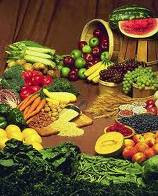One of the best ways to look and feel great and make your exercise routine more efficient is by eating healthy foods. Healthy foods give us the energy we need to perform properly mentally and physically, and build muscle during our workouts. Eating healthy is sometimes tricky since supermarkets are filled with convenient, overly processed foods and labels are often misleading and difficult to read. Here are a few tips for healthy eating and shopping for food.
Shop Fresh Foods from Outer Aisles of Supermarket
Choose a variety of healthy foods such as whole grains, fruits, vegetables, lean proteins and dairy. When selecting your fruits and vegetables, add a lot of color to your plate for optimum nutrition. The fiber and water the fruits and veggies contain can decrease your appetite and make you feel full faster. Most healthy foods are located on the outer aisles of the store and have very few ingredients. The less ingredients contained in the food, the better for you. In the center aisles you will mostly find processed and convenience foods that are fast, but high in sugar and sodium. Food in boxes and cans need preservatives to stay fresh, which mean less healthy vitamins and nutrients. Most of your food should be “whole” containing limited ingredients, bought from the outer aisles, and be kept in your refrigerator or freezer instead of your pantry.
Read Labels
Nutrition label reading can be very tricky. Packaging is often disguised to make you think the product is healthy. When you see “low fat”, “natural”, “enriched”, it doesn’t mean it’s all good. Remember that these labels are often a way of distracting you from the truth. The only way to know the ingredients and nutritional content is to read the label.
Start at the top and look at the serving size and servings per container first. Don’t be fooled. Many single serving foods are divided into two servings. If the serving is for 1/2 cup and you eat 1 cup, remember to double all your nutrition facts. For instance, many cereals have 10 grams of sugar for 1/2 cup. If you eat a whole cup you are eating 20 grams of sugar. It makes a big difference.
The next part of the label are your calories, the nutrient breakdown and percent of daily value. It is important to remember that food labels are not tailored to your individual needs, and you may need to adjust the nutrients to meet your nutritional goals. The daily values make recommendations based on a diet of 2000 or 2500 daily calories. Fat, cholesterol and sodium should be limited as they may increase risk of obesity, heart disease, diabetes, and high blood pressure. Fiber is important to help with digestion and regularity among other things. Aim to have at least 25 grams of daily fiber intake from whole grains, fruits, vegetables or Shakeology.
As a hypoglycemic, I need to limit my servings for sugar, fat, and cholesterol. I look for between 4-7 grams/serving of both fat and sugar, and cholesterol labels should be under 25 grams/serving. If an item has more than 7 grams of sugar, then I look at the ingredients to see what kind of sugar. The first 3 ingredients are the most important in label reading. They are what is used the most in the item. Sugar can be disguised. If the first 3 ingredients are high fructose corn syrup, sugar, molasses, sucrose, honey or anything sugar related, and it’s higher than 7 grams of sugar, I don’t buy it. If it’s lactose sugar(from dairy) or fructose sugar(from all natural fruits) it’s safe for me. I also look for “whole grain” product labels which are very deceiving on pastas, rice, crackers, and breads. Remember, if it doesn’t say “whole” in the first ingredient, it isn’t whole grain and it will convert to sugar and digest quicker.
Be Smart with Beverages
Your body needs to replenish its water frequently. Remember to drink at least 64 ounces a day. Trade in your soda or energy drink for water! They contain a lot of sugar, and high fructose corn syrup. Even diet soda is not good for you. Studies have shown diet soda contributes to weight gain. The sweet taste signals body cells to store fat and carbohydrates, in turn making you hungrier. Also, the taste of sweetness promotes insulin release, which blocks your body’s ability to burn fat. Have you ever noticed after drinking a diet soda you are hungrier?
Write a List and Stick to it
Plan your meals out every week, write your list accordingly, and keep a journal or food diary to keep you on the right track. Try not to add too many items that are not on your list when shopping. If you have trouble planning out healthy meals and ingredients, you could use Team Beachbody’s Meal Plan Wizard as a club member for only $2.99/week. It will plan out your 5 small meals per day each week fully customized to your food preferences, weight loss/health goals, fitness program and more, and generates a printable shopping list each week for convenience. As a club member, you will get a 10% discount on all products such as P90X, Insanity, TurboFire, Shakeology, P90X protein bars, resistance bands, chin up bar, etc. Click here to find out more about Team Beachbody membership.
If you have any questions or comments feel free to contact me at fitwithmolly@gmail.com and visit my website for fitness programs, meal plans and more at www.beachbodycoach.com/fitwithmolly.



